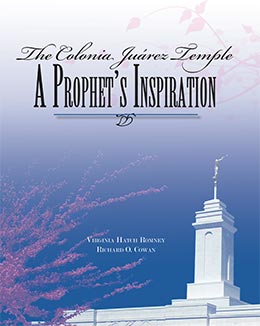The Push to Completion
Virginia Hatch Romney and Richard O. Cowan, The Colonia Juárez Temple: A Prophet’s Inspiration (Provo, UT: Religious Studies Center, Brigham Young University, 2009), 65-88.
February 15, 1999, was the target date for completing the temple’s construction. This meant that less than two months remained following the placement of Moroni atop the tower. These weeks witnessed a flurry of activity as work on the temple reached a fever pitch.
Truly a Community Effort
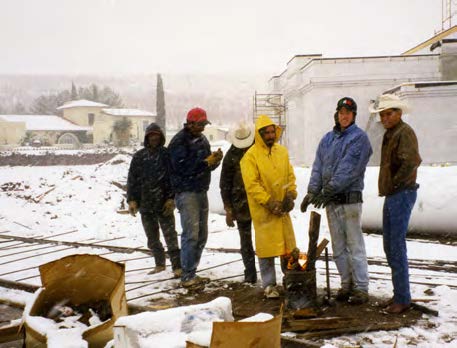 Concrete crew continues working despite blustery weather in early December.
Concrete crew continues working despite blustery weather in early December.
Fortunately, for the most part the winter was relatively mild, but there were some exceptions. On December 10, a storm had left the temple site covered with about five inches of snow. This halted all outside work except for that done by the concrete crew. They had to warm their hands over a small fire they had kindled, but they still stayed on the job.
The interior crews were not bothered by blustery weather. Outside, extreme cold didn’t seem to affect the construction progress as much as the wind did. January 21 was particularly challenging. The marble, caulking, and landscaping crews were having a terrible time trying to keep the dirt out of their eyes and to keep their balance on the scaffolds. One employee standing on the fence made a cardboard shield for his back to protect him from the west wind. This wind was the first real test for the figure of the angel Moroni, and it withstood well.
Even full-time missionaries serving in the area helped to build the temple. Each was encouraged to put in at least four hours of service each week and found that working at the temple was a rewarding way to serve. Often the missionaries would come to temple days with the ward where they were serving and work alongside the members.
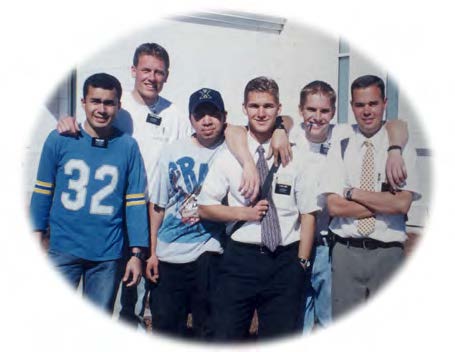 Full-time missionaries assisted in the temple’s construction, including, left to right, Elders Sastre, Glanzer, Águila, Bird, Manning, and Jenks.
Full-time missionaries assisted in the temple’s construction, including, left to right, Elders Sastre, Glanzer, Águila, Bird, Manning, and Jenks.
Elders Chad Jenks and Chris Bird served in Colonia Juárez and enjoyed working on the temple site weekly, lending a helping hand in a variety of activities. They feared they might be transferred to another area before the open house and dedication but were excited when transfers were made, and they were left in the area. Elder Jenks said: “When I first arrived in Colonia Juárez from my transfer in November, I was told that a temple was being built right up the street. I thought, ‘This has to be the best place in the mission right now.’ It was a great experience to have been able to help build the house of the Lord. It was an experience I will never forget. And to see all the members in the area sacrifice their busy time to literally build the temple was just truly amazing. The member support for the missionary work was great during my time here, even when all were busy helping at the temple.”[1]
His companion, Elder Bird, spent over five months in Colonia Juárez. Besides being impressed by the beauty of the temple, he was moved by how all the town’s people came together to get the temple finished. He was impressed with how they dropped what they were doing and put all their time and effort into the temple. He watched as closer friendships were established because different wards and cultures worked together. He continued, “What better thing could there be on earth to bring people closer together than a temple? I think nothing.”[2]
Other elders and sisters serving in the area agreed: “The members are very excited and are more involved in fellowshipping. Many less-active members, along with the active, are preparing to go to the temple. There is a different spirit in the whole state of Chihuahua. Even though people in general don’t know about the temple, it is making a difference.” Twenty-five members were activated in the Juárez Second Ward. A branch was reopened in the nearby small town of San Diego with twelve to eighteen members attending each Sunday. The missionaries observed that temple construction enabled and motivated members to share the gospel: “There is a lot of missionary work going on because going to the temple is now a realistic goal for many.”[3]
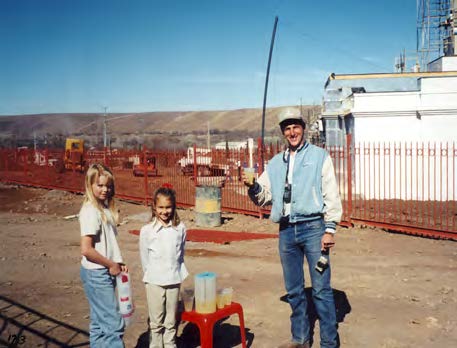 Kassidie Romney and Ashley Shumway offer welcome lemonade to David Wills.
Kassidie Romney and Ashley Shumway offer welcome lemonade to David Wills.
The Spirit was also felt among the temple builders. From the subcontracted workers came many questions about the Church and the purpose of temples. Several great referrals resulted. Workers, whether Latter-day Saints or not, felt the spirit of the project and conducted themselves differently.
One day in late December, in keeping with the spirit of the holiday season, Kassidie Romney and Ashley Shumway (about nine years old) set up a lemonade stand outside a temple gate. As they saw Virginia Romney down by the temple, they called out to see if she would like some lemonade. Thinking they were selling it, she responded that they had caught her with empty pockets. Their response was, “Oh no, we are giving away lemonade to the temple workers.”[4] David Wills was in sight, so he was called to come and get some free lemonade. He thanked the young girls and then called out to nearby workers to come and get some. Soon men were descending ladders and coming from all directions for a very welcome refreshment. When the lemonade was gone, the girls ran home and made some more.
On December 24 the installation of the window glass started on the southeast corner of the temple. The glass in the celestial room windows and temple interior was custom-made for this temple.
Henry Carsten, a Church member from Professional Painting, started to hang the vinyl wall coverings on December 29. He had already hung wall coverings and murals in about thirty-three temples and visitors’ centers all around the world. The celestial and sealing room wall coverings came from Germany. They were chosen specifically for this temple. Henry explained that each temple has its own unique interior design, including decorative paintings, chandeliers, carpets, marble, and furniture and are chosen to reflect the culture of the area.
This was the forty-first temple that Greg Hill, manager of interior temple design for the Church, had decorated; he had previously decorated the Mexico City Temple. He spent a substantial amount of time acquiring a feel for what was typical in Mexico and developing a closeness to members in the temple district. He explained that finding the correct furniture was a lengthy task because the Colonia Juárez temple was unique. Brother Hill used a Spanish colonial theme as he chose furnishings for the temple. He was especially pleased with the chandelier in the celestial room, which was a style he had never used before. Most of the furniture in this and other rooms was custom-made in order to maintain that theme. Adapting the style for each temple enables members to feel that their temple belongs to them.
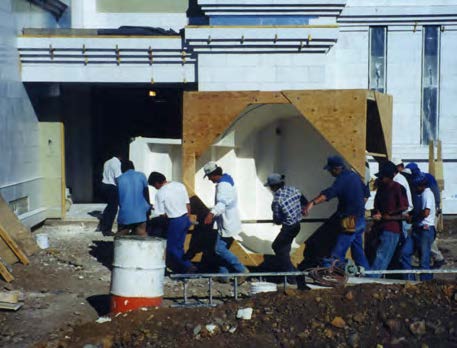 The font was carried into the temple before metal door frames were installed, December 22, 1998.
The font was carried into the temple before metal door frames were installed, December 22, 1998.
While materials from within Mexico were used whenever possible, some items needed to come from north of the border. These items were openly declared to customs officials and taxes were paid. On the last day of December 1998, a shipment arrived consisting of marble, altars, a recommend desk, doors, folding partitions, cabinets and even the new Dublán chapel organ. Another big shipment of supplies from the United States arrived by flatbed trailer on January 22. This shipment consisted of lockers, stall dividers, and acoustical panels. As was the case many times before, volunteers, including youth, were on hand to help unload the trailer.
Often tasks had to be accomplished in a particular order. For example, on December 22, about a dozen men carried the heavy font into the temple and lowered it into the baptistry area. That had to be accomplished before the metal doorframes were installed early in January. On the ninth of that month, Ron Dalene began installing the baptismal font. David Wills, who subsequently supervised the installation of fonts at temples in Hermosillo and Ciudad Juárez, recalled that none of them went together like the one at Colonia Juárez. On January 16 the chandelier in the baptistry was assembled and hung by David Wills, Chad Call, Ron Dalene, and some volunteers.
Two days later the oxen were taken up to the temple and installed around the base of the font. The next day the stainless steel railing of the baptistry was begun by two men from Carver Sheet Metal in Salt Lake City; one of them, Jason Carver, had been a missionary in Nuevo Casas Grandes two years earlier. This company was responsible for the installation of all the stainless steel in the temple and the white aluminum wall caps on the exterior.
On January 6, with the installation of exterior windows and doors completed, the furnace was turned on. Because it was the middle of the winter, the interior workers were very happy with this improvement.
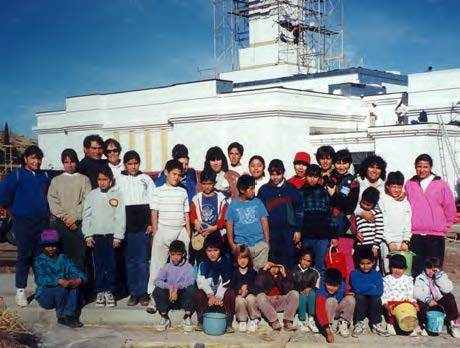 Above: Alamedas Ward Primary children helped sand the metal fence. Below: Huertas Ward young women gathered names for temple work and were among youth groups who volunteered
Above: Alamedas Ward Primary children helped sand the metal fence. Below: Huertas Ward young women gathered names for temple work and were among youth groups who volunteered
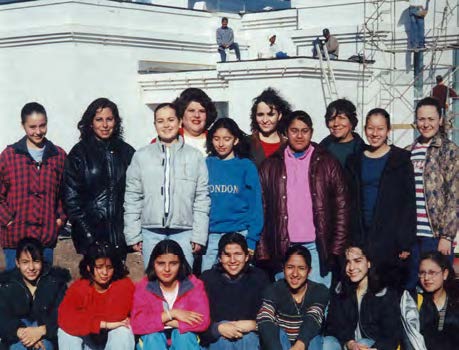
January 9 dawned a beautiful and perfect day for a two-stake temple day. At one point more that three hundred people were raking rocks and hauling them off in buckets and wheelbarrows, sifting and leveling topsoil, driving many kinds of equipment, digging trenches, and installing sprinkler systems. Others were sanding the perimeter fence. All had jobs to do and felt they were making a contribution. There was a beautiful spirit of unity and peace as members worked together. This was their temple, and they recognized what a wonderful opportunity it was to be part of it.
One week later, on another two-stake temple day, a large group of Primary children from the Alamedas Ward came with their leaders to sand the fence. Thirteen young women and their leaders from the Huertas Ward came to work on the grounds and have their picture taken. They as a group provided over one thousand names that were ready for ordinances when the temple opened. In December, they had gone to the Mesa Arizona Temple and performed 271 baptisms for the dead. They were anxious to do the rest of the baptisms in the Colonia Juárez temple as soon as it opened. Many other members from all wards and branches were present. That day a crew of hardworking women was in the temple cleaning and preparing for the installation of the carpets.
Help from the Sisters
Michele Call, whose son Chad was the assistant to the construction manager, became intimately involved as the pace of the temple’s construction intensified:
I guess the way I was given my job was because of the way a son calls his mom for help when a crisis arises. Whenever there was an odd job to do or a mess to be cleaned up, my son Chad would call me on the phone and ask for my help. If it were a major mess, then he would ask me to bring a few sisters to help. It just continued until I was given the title ingeniera de limpieza (cleaning engineer). It got to be kind of a joke. The carpeting was installed a little early, and there was still so much construction left to do. I was so concerned about the condition of the carpet and its care that the job was handed over to me to watch out for and keep the carpets clean. I never realized how difficult it would be, but the workers got used to seeing me carry my vacuum cleaner around and always remind them to clean up after themselves. What else are moms for?
When odd jobs arose and when time was running out, women provided needed help. They sanded, caulked, painted, patched wallpaper, mopped and vacuumed, carried out garbage, helped to prepare a room for the next crew to start a job, and cleaned up each night. Many spent days on these tasks. “No job was too difficult and no task too big for us to do for our temple,” Michele affirmed. Their service was reminiscent of the service rendered by the Kirtland and Nauvoo women to the temple builders of their time.
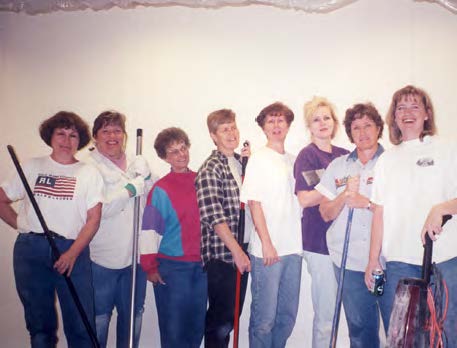 Left to right: Ellen Turley, Michele Call, Bon Adelle Skidmore, Gay Longhurst, Gwen Romney, Debra Spilsbury, Virginia Romney, and Deanna Romney. Courtesy of David Wills.
Left to right: Ellen Turley, Michele Call, Bon Adelle Skidmore, Gay Longhurst, Gwen Romney, Debra Spilsbury, Virginia Romney, and Deanna Romney. Courtesy of David Wills.
Mobilizing other women to help became Michele Call’s responsibility: “I remember one day when I was driving my children back to school after lunch and time was short, I passed by a sister who was walking down the street. She was here visiting and doesn’t get into town very often. I felt that she would enjoy an opportunity to help. So I stopped to ask her if she would like to come up to help clean in the temple that afternoon. Tears welled up in her eyes as she answered yes. It meant so much for her to be able to help in the Lord’s house.” Michele continued:
I have so many special memories made inside this temple. I was asked if being in the temple every day would take away this special surprise at the open house, or if it would make the temple too common. To this I have to say no. As I was sitting on the floor of the endowment room scrubbing out stains in the carpet, a feeling came over, me, tears came to my eyes, and I was covered with tingly goose bumps. I had been in that room cleaning many times before but now that the room was almost totally complete, I was in awe at its beauty. I envisioned the members of our ward seated around me and remembered the special messages that would be heard right here in our temple. Words cannot express the joy I felt. I love to sit in any of the rooms after I’ve finished cleaning and soak in the aura that I feel there—priceless moments to be treasured forever. [5]
Michele felt that the most delightful part of this responsibility was getting to know the workers who came from outside the colonies to help finish the temple. She believed that having the sisters around helped to keep everyone in better spirits. Living in a motel was sometimes hard on the different crews, some of whom stayed for weeks at a time. The women would bring home-baked cookies and rolls, Christmas treats, pizza, and other food, anything to keep the workers happy. It gave everyone a chance to get better acquainted. Some of the men shaved off their beards, and smiling became more popular. Many made friends and found it difficult to say good-bye. Some even talked about returning and bringing their families.
In mid-January, the two-strip concrete shortcut up the hill was poured. Also, in the midst of all the pressures of reaching the construction deadline, project supervisor David Wills had to take off four days to drive to El Paso, where his wife, Janet, delivered their sixth child.
The Final Flurry of Activity
At crucial junctures during the temple’s construction, workers with specific skills continued to come from Utah to lend a hand. On January 9 a craftsman came to install the sealing room’s movable partition wall. About this same time, when the Cobaco team was behind schedule in caulking the joints between the marble slabs of the temple’s exterior, two caulkers were sent from Salt Lake City to help.
Many of the crew members were either less-active Latter-day Saints or members of other faiths, but several of them still chose to attend Sunday services in the colonies. One of the nonmember painters asked for the missionaries to visit him after he returned home to Utah. A Latter-day Saint worker who had not been to Church in over fifteen years announced he was going to start preparing to take his wife to the temple. As some of the painters were leaving, one commented, “Well, I won’t miss the food or the accommodations or even the traveling, but I sure will miss you people.”
A very peaceful feeling prevailed at the temple site on Sundays. In the late afternoon visitors would go up to admire the temple and the grounds. The noise created by the workers and their heavy equipment was absent, a marked contrast to the noisy activity of the week.
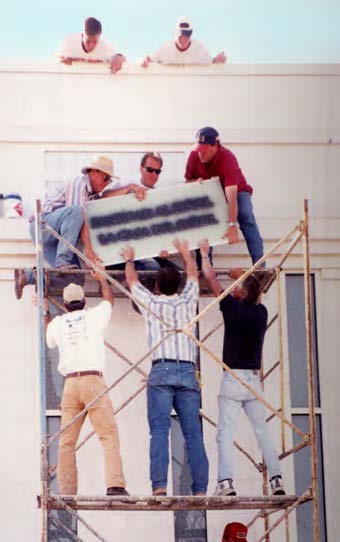 Workmen and volunteers install the inscription proclaiming “Holiness to the Lord” in Spanish on the temple’s east front.
Workmen and volunteers install the inscription proclaiming “Holiness to the Lord” in Spanish on the temple’s east front.
Early Monday morning, January 18, everyone was busy at work. With the February 15 deadline less than a month away, all were feeling the urgency of time running out with so much left to do. Some projects were behind, and supplies were running short or had not yet been delivered. Two carpet layers, one of whom had married a girl from the colonies, came from Salt Lake, donating their time (although their airfare was paid). They began installing carpets in the celestial and endowment rooms. They were unable to finish in the entry and baptistry because of activity going on in those areas. They left at the end of the week, agreeing to come back at a later date to finish.
On January 20, three skilled painters from Salt Lake City began working in the celestial room. They did all the decorative painting and gold leafing in that room, the sealing room, the baptistry, and the lobby. In order to minimize the time these specialists spent at the temple, the Church tried a new pilot process, which consisted of prepainting the vinyl fabric at their studio before installing it in the temple. Normally the painters spend several months at a temple, but this new procedure allowed them to leave after only two weeks.
Landscaping progressed slowly. On January 21, when much of the dry topsoil and mulch blew away, landscapers realized that the sprinkler system needed to be operational as quickly as possible. That very afternoon the sprinklers were turned on for the first time. The first six pine trees were also planted by the parking lot.
Quarry Direct of Utah supplied the last seven thousand square feet of exterior marble, which came from Durango. They also provided the three signs adorning the exterior of the temple. On January 25, five employees of Wasatch Tile and Marble, the same company which had worked on the Monticello Utah Temple, began working with Cobaco’s men on the exterior marble.
Quarry Direct was also awarded the contract to install the interior tile and marble. Eloy Ruvalcaba, their business manager, spent three days at the international border importing a load of interior marble, tile, railing, and other supplies. The interior marble for the baptistry area and entryway came from Italy. Also on January 25, tile installation began in the bathrooms and around the baptismal font. Much of this company’s work was donated.
Quarry Direct contracted Marmoles Dina Mex to do technical interior marble work. They installed marble countertops, sinks, altars, and the recommend desk, with marble from near Torreón. Generally, marble was cut into standard sizes too small for the temple countertops, which were to have no seams. Therefore, Paul Bowman, an owner of Quarry Direct, went to the mine, arranged for them to cut larger blocks, and stayed there to make sure it was done.
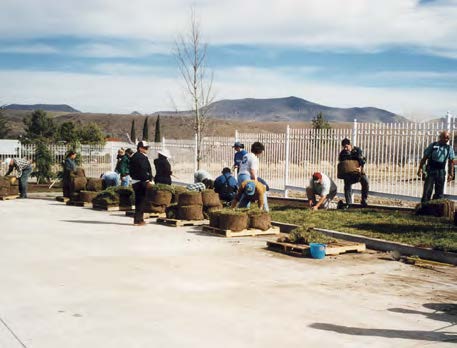 Academy faculty help with landscaping on January 28.
Academy faculty help with landscaping on January 28.
That same day the celestial room chandelier was hung, and on the next day the crystals were added. When the shipment of these materials arrived, a small rod from one of the small side lamps appeared to be missing. Effort was made to try and find it, but where were they to look? Chances of finding that one little part in all the rubble was very slim. Dave Brown was walking by the pile, spotted a little wadded up brown paper, and picked it up, not even imagining that it contained the lost piece. It did. Greg Hill said it was nothing short of a miracle that it was found.
While construction was being completed inside the temple, landscaping progressed outside. The hillside above the academy campus was planted with wheat. The academy faculty members were anxious to have an opportunity to work together on the landscaping, so school was dismissed at noon on Thursday, January 28, and they laid sod in the parking area for the rest of the day. The following day the first shrubs were planted and bark mulch was spread around them, also in the parking area. That same day, sod was planted adjacent to the temple. Much work had gone into preparing this area for planting. Sod was cut from the field up the valley. A good portion of this sod was in place by the end of the day, thanks to the landscaping crew and many volunteers. Now there was finally some green around the temple.
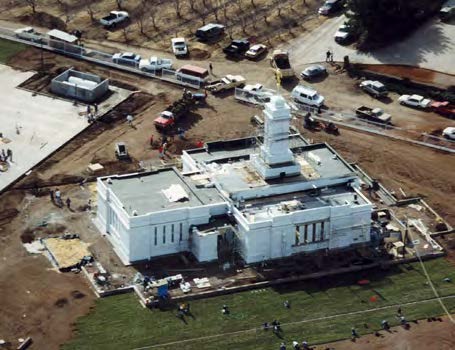 Above: Landscaping makes progress around the temple, January 30, 1999. Courtesy of Marvin Longhurst. Below: Primary children from Colonia Dublán helped sweep the parking lot.
Above: Landscaping makes progress around the temple, January 30, 1999. Courtesy of Marvin Longhurst. Below: Primary children from Colonia Dublán helped sweep the parking lot.
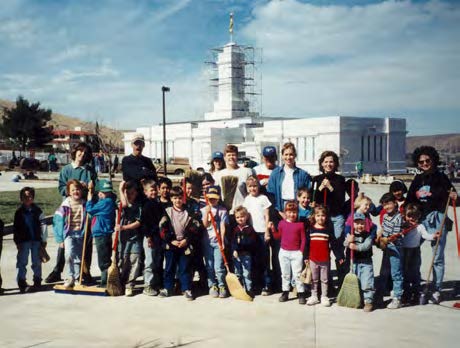
The Dublán First Ward Primary children came up with their leaders on January 30 to sweep the parking lot. The landscaping committee was busy keeping the many projects and volunteers going. Twenty women were inside the temple washing and drying all of the woodwork and marking it for defects because two painters would return from Utah to do touch-up work inside the temple.
Pressures were mounting about this point because David was scheduled to turn the temple over to the Church on February 15, which meant only two weeks remained to complete all phases of the construction. There was so much left to do. However, there was great support as paid crew members and volunteers pulled together to accomplish the task. Some of the Saints came as families. One four-year-old boy reflected their spirit as he worked side by side with his father and remarked, “We are finishing our temple, aren’t we, Dad?”
For weeks David Wills and Chad Call were averaging anywhere from two to six hours of sleep per night. After very strenuous days, they would stay late into the night tying up loose ends and organizing for the next day, perhaps catching only a couple of hours of sleep on the celestial room couches. Before Christmas, David was asked if he was getting stressed and in his positive cheerful way responded, “Sure.” Not only did Brother Wills have the responsibilities of the Colonia Juárez temple, but by this time Jacobsen Construction had also made him responsible for the temples in Hermosillo and Ciudad Juárez, which had groundbreakings in early January and were being built simultaneously.
An angel of mercy stepped in to help David weeks before this time. LaVon Whetten, activities director at the Academia Juárez, had been serving as transportation coordinator. She coordinated arrivals and departures of workers and representatives from the Church headquarters. For weeks she was on the road every day between Colonia Juárez and El Paso, 180 miles away, meeting and dropping off crews at the El Paso airport. Many times she made trips to El Paso to pick up supplies shipped down from Utah or to purchase others. When trips overlapped, she found others willing to help out. David Brown’s new white Suburban became the official shuttle. She and others made their personal vehicles available for crews to get back and forth between Nuevo Casas Grandes and Colonia Juárez. David Wills appreciated her sacrifice because she refused compensation for fuel, food, and accommodations.[6]
 Above, front to back: Joan Thomas, DeAnne Whetten, Christine and Kelly Romney, Maurice Bowman planting flowers. Below: Obrera Ward bishop Pedro Vazquez and other volunteers.
Above, front to back: Joan Thomas, DeAnne Whetten, Christine and Kelly Romney, Maurice Bowman planting flowers. Below: Obrera Ward bishop Pedro Vazquez and other volunteers.
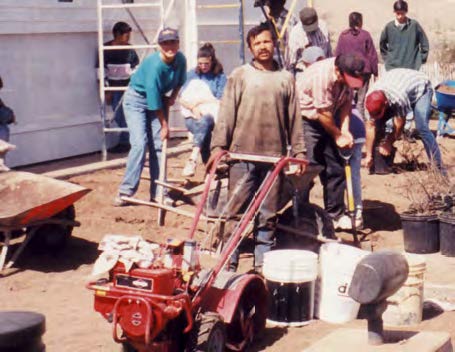
As the rush to completion became increasingly hectic, the safety and health of the workers continued to be a major concern. Additionally, needed materials sometimes ran short, and there didn’t seem to be enough time to replace them. Some obstacles appeared insurmountable, but there was always a way. Those responsible for building the temple believed prayers were answered, and they recognized the hand of the Lord over and over again as solutions to problems came in various forms.
February brought a wide variety of activities as the construction deadline loomed. On Monday, the first day of the month, three big pine trees were planted in the northwest corner of the temple site. On Tuesday evening, David Wills, Chad Call, and six volunteers assembled and installed the sealing and brides’ room chandeliers and crystal sconces on the walls. On Wednesday a semitrailer full of temple furniture, mirrors, and supplies arrived from Salt Lake City. The concrete truck was pumping out concrete daily. On Thursday acoustical tile and panels were being installed in the president’s office and the endowment room. The panels in the temple were made of 1 1/
Many wards were represented at the next temple day on February 5. Jeffrey Max Jones from Dublán, a member of Mexico’s Federal Congress, was there on crutches (following a recent injury) with his two daughters, raking and shoveling up pieces of discarded marble and other debris around the temple. Chad Call had youth on the tower on Friday and all day Saturday cleaning off the marble. That evening they started to disassemble and lower the scaffolding from the tower; when this was completed on Monday, for the first time there was an unobstructed view of the tower and angel. On Saturday the youth helped remove furniture from the construction office, which was to be torn down. Maxie Spilsbury donated a small travel trailer which became David and Chad’s temporary home.
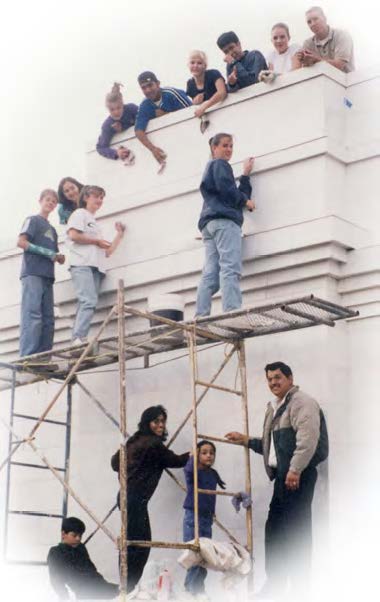 Youth and the Jaime and Hilda Beltran family cleaning temple’s marble exterior.
Youth and the Jaime and Hilda Beltran family cleaning temple’s marble exterior.
Saturday evening a camper truck drove up, and three adults and three children got out. The temple was illuminated with floodlights and the interior lights were on, making it a spectacular sight. The visitors were looking at the temple in awe. They asked, “What is this building? Who is building it? What is it for? What do you do inside? It is really beautiful.” The questions and comments continued until Greg Hatch, a recently returned missionary, passed by and helped answer their questions. They were from Chihuahua City visiting Nuevo Casas Grandes and had driven to Colonia Juárez to see the town, not knowing about the temple. As they were coming down into town, they saw the beautiful illuminated building on the far hillside. Keeping it in view, they arrived at the site. The temple can be seen from as far away as Mata Ortíz, ten miles to the south. It is truly a beacon on a hill.[7]
The second week in February, just before the completion deadline, witnessed a variety of more technical tasks being completed. Large heating and cooling systems and telephone equipment were installed and tested. A representative from Honeywell worked on the control panels in the mechanical room, two floodlights on the north side of the temple were repositioned, and chairs were installed in the endowment room. Working with Ken Farnsworth from the local temple committee, technicians from Church headquarters installed the temple’s audiovisual systems.
The Final Inspection
Monday, February 15, was a busy day. Members from the Church Temple Construction Department had come for the final inspection. These members included architect Vern L. Martindale, project administrator Mark R. Schaffer, and interior decorator Greg E. Hill, together with representatives from the engineering and purchasing divisions. Brother Martindale commented that it was more beautiful than he had expected and that the workmanship was superior. They were also very impressed with the youth who were still working daily at the temple.
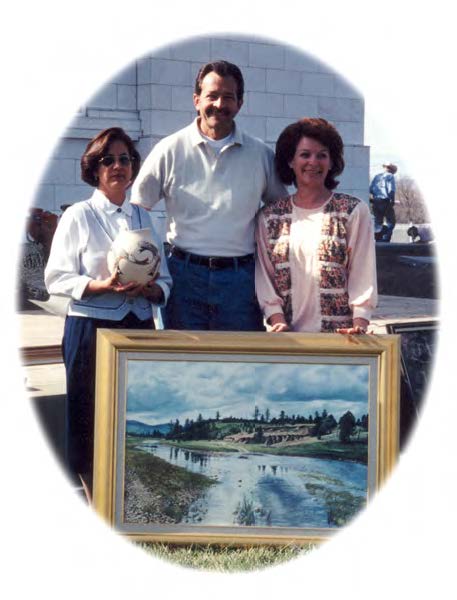 Lydia Quezada Talavera and LaVerne Cluff Price present their works of art to Greg Hill for use in the temple.
Lydia Quezada Talavera and LaVerne Cluff Price present their works of art to Greg Hill for use in the temple.
Greg Hill had asked Bon Adelle Skidmore, who was serving with her husband as a construction missionary, to help him find an oil painting and another piece of art from local members that he could use in the temple. After much research, pictures of possible acceptable items were sent to him in Utah. In 1985 LaVerne Cluff Price had created a beautiful oil painting of Temple Hill in Pacheco, one of the original Mormon colonies. She was pleased to donate this to the temple. Lydia Quezada Talavera, sister of the world-famous Indian potter Juan Quezada from the nearby pottery center of Mata Ortíz, was approached about making a pot especially for the temple. This she did with great care and humility.
On Tuesday, February 16, a short ceremony was held outside the temple where Sisters Price and Talavera presented their artwork. Greg Hill had brought a sample of a picture frame he had used at a temple in Germany and asked LaVerne if she thought she could provide a frame just like it. She took the sample, and tears came to her eyes as she realized it was identical to the frame already on her painting. “Wow, the Lord really takes care of His own, doesn’t He?” she remarked.[8] Lydia Quezada said, “I wanted to make a special pot. I wanted it to be perfect for the temple. I worked and worked on it. But because it all has to be done by hand, I’m afraid it’s not as perfect as I wanted it to be; I did my best.” She pointed out how all the delicate lines intertwined, without running into each other, creating a continuous unity of movement around the pot.[9]
Even though the February 15 deadline had passed, there were still many loose ends to tie up. These included stuccoing retaining walls and pouring concrete for the perimeter roadway. Once again, youth and other volunteers performed such tasks as painting the attic catwalk, scraping and cleaning the exterior marble, raking and leveling soil, laying sod, hauling and planting trees and bushes, and cleaning up trash. Many worked as late as midnight. Brad Cooyman from Utah sculpted beautiful designs in the celestial and sealing room carpets. The Jones family of the Dublán First Ward painted lines in the parking lot. Glass was installed around the baptismal font. Students from the academy spent several days cleaning the marble. Israel Guzman cut out the aluminum plate in the cornerstone area.
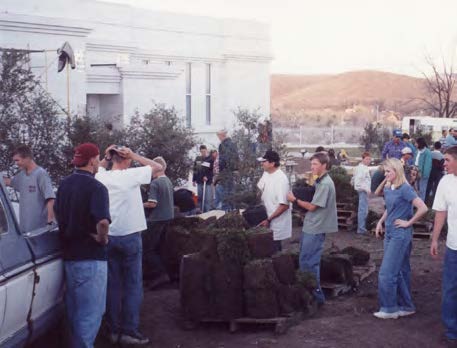 Above: Youth volunteers performed a variety of tasks. Below: Philip Taylor Jr., Quintin Hatch, visitor Regan Warner, and Randall Hatch.
Above: Youth volunteers performed a variety of tasks. Below: Philip Taylor Jr., Quintin Hatch, visitor Regan Warner, and Randall Hatch.
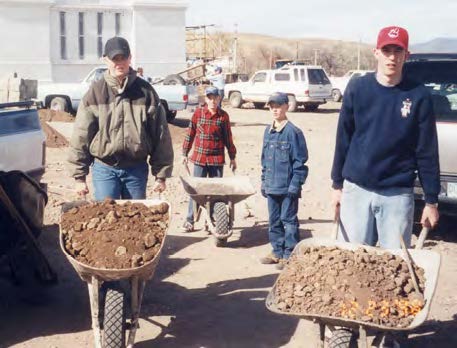
All of the temple furniture and many paintings were unloaded, uncrated, and moved into the temple. Because the many beautiful paintings were temporarily placed in the Endowment Room, David Wills called it Brother Hill’s art gallery. Greg Hill also made a beautiful floral arrangement for the celestial room.
After much last-minute hard work, the temple was ready to be turned over to the Church on Wednesday, February 24. Keith Stepan, manager of the Church Temple Construction Department, came that day. A special ceremony was held inside the temple where many feelings were expressed and tears were shed. Construction manager David Wills turned the keys over to newly appointed temple president Meredith Romney. Elder Richard Skidmore, with much emotion, described this occasion as a “big thumbs up.” Representatives of the Temple Department, as well as Elder Eran A. Call, president of the Mexico North Area, who had come from Monterrey, were thrilled with the excellent workmanship inside and outside the temple, including the landscaping.
During the week between the open house and the dedication, there was much work remaining to be done around the temple. The word spread that help was still needed, and once again many, both old and young, responded. The Saints felt a little sad that the wonderful opportunity of working at the temple was coming to an end, and they took advantage of every opportunity to contribute.
Some Reflections: Lives Touched
For many, working on the temple was a life-changing experience. Perhaps no single individual had more to do with the success of the Colonia Juárez temple’s construction than did David Wills, Jacobsen Construction Company’s on-site project manager. As this project drew to a close, he reflected, “When I received the opportunity to help build the Colonia Juárez Chihuahua Temple, I had no idea how much of an impact it would have on my life and how it would change me. Because of this opportunity, I am a better person. This past year and a half have been the most difficult years of my life, but yet have given me the most rewarding moments of my life. With an air of extreme excitement and trepidation, I started the preliminary work on the temple in 1997. I didn’t know what to expect. I had never been in Mexico before, but I knew that this was the Lord’s work and that He would lead me in the way I needed to be led.”[10]
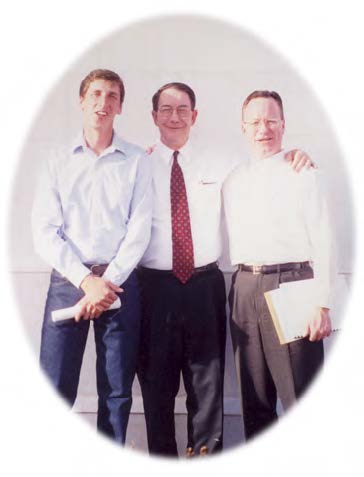 Project manager David Wills meets with Keith Stepan of the Temple Construction Department and Thomas Coburn of the Temple Department at the time of the final inspection.
Project manager David Wills meets with Keith Stepan of the Temple Construction Department and Thomas Coburn of the Temple Department at the time of the final inspection.
David was convinced that his family had been blessed as well. “My wife, Janet, learned patience as I was seen less and less at home, to the point she would visit the temple just to see me.”
Brother Wills appreciated his interaction with the colony Saints. “I will never be so impressed with a group as I am with the people here. These people have become my best friends and also my heroes and examples for life.” In addition, Brother Wills was particularly impressed with the people he worked with. “As problems arose, so did the people who had the ability to solve them.” He regarded this as one of the miracles connected with the temple’s construction. “Even the nonmembers involved in the temple were worked upon by the Spirit to accomplish very difficult tasks in workable ways.”
“It wasn’t work at all, but a labor of love,” he reflected. “The Spirit of the Lord was there. As the construction deadline neared, the Spirit grew stronger. Without the Lord’s help and that of the members, we would have never finished on time.” Despite difficulties in importing needed materials, there were never any delays due to needed items not having arrived. “I will never doubt the Lord’s hand in the construction of the temple. As we progressed, it seemed that when things looked impossible, they always worked out.”
The contributions of certain individuals stood out to Brother Wills. When Chad Call finished high school, he was initially hired to dig trenches, but when Dave needed help with some paperwork, the young man was brought into the office. “He caught on to the items quickly, and he grew to become indispensable in the construction of the temple,” Dave acknowledged. “He was doing the work that I did when I first got out of college at the age of twenty-six.”
Similarly, Dave appreciated Ron Dalene, who started as a volunteer but was soon hired as a regular employee. He increasingly used “skills that he did not know he had,” culminating with the installation of the baptismal font.
Marvin Longhurst “donated thousands of hours with his heavy dirt-moving equipment and never asked for a penny,” Brother Wills gratefully recalled. “The work that he had scheduled for the equipment on his own projects was rescheduled so the work at the temple could continue without any delays. Many times Marvin brought his equipment onto the temple grounds and always at the time we needed it.”
David recalled how Michele Call and Deanna Romney were able to leave family responsibilities for days at a time to work at the temple. He was grateful the Skidmores had come on their missions three months early and were also able to help. When he needed help from Utah companies, “somehow their schedules would clear so they were able to help on the temple. . . . I can go on and on over the items that just came into place so that this temple could be built in the quality that the Lord needed in the time frame that was required.”
Brother Wills was impressed with the broad financial support the members provided. Even those with small incomes donated for their temple. “When the contractor wasn’t able to keep up the schedule for the landscaping,” Brother Wills continued, “I approached the Church in Salt Lake City with a plan to allow the members to do the work. I approached the two stake presidents to ask if they wanted to take on the responsibility of the entire project. Their comeback was, ‘Don’t worry about the landscaping. The members will take care of it.’ And from that point on, it was taken care of.” The members put in tens of thousands of hours. He was especially amazed that so many men left their own work and gave substantial amounts of time and equipment and yet did not suffer economically.[11]
Janet Wills said that Heavenly Father kept a watchful eye on their family and that she particularly appreciated the many friends they had made. She stated that the completion of the temple was “such an exciting time, but also a very sad time for our family. It is now time to move on.” She said, “Many things have happened to strengthen our family’s faith and commitment to the building of Zion. . . . Our children have learned what being an active member of the Church is really all about and the blessings service can bring. . . . Many people have thanked us for our sacrifice in being here in Mexico, but we don’t see it as a sacrifice; we see it as a blessing that we never dreamed we could receive.”[12]
Chad Call reminisced about his intimate involvement: “This temple is like a child to me. I have been with it since its very birth. I have lived with it and grown up alongside it. . . . How I thank the Lord each day for this great blessing He has brought into my life in letting me participate in this temple construction.”[13]
As Elder Richard Skidmore’s four months of mission service in Colonia Juárez came to an end, he reflected, “It has been a great joy for me to get into the hands-on part of carpentry work that I have loved for forty years.” Despite some construction challenges, he was impressed with the people he met in the colonies. “It has been a great privilege to get acquainted with special people and their skills. . . . It has been very touching watching up to four hundred people at one time working side by side on the landscaping.”[14]
Jay Nielsen, one of the recently returned missionaries recruited by Adam Hatch, confided: “I never dreamed I would have the opportunity to help build a house of the Lord, much less in my own hometown. The blessings I have received have been innumerable. I will never forget this wonderful experience and the many things I learned. I hope that we will all take advantage of attending this temple and that we will appreciate our Heavenly Father’s blessings.”[15] Benjamin Quintana, the other returned missionary who worked with Adam, recalled, “It was a very special moment for me when I first heard there would be a temple built in this small corner of the world. But I have felt greater emotion as I have had the opportunity to lend a helping hand in the construction of this temple. . . . I know it will be a great blessing for everyone, not only for the living, but also for the dead. I love the Lord’s Church, and I will strive to live as I should.”[16]
While the process of building a temple in the colonies had a tremendous impact on the lives of those living in the area, it was an equally powerful experience for many who came from Utah to Mexico to work on the temple. For example, Larry Lemmon, a caulker sent from Salt Lake City, recalled feelings during his first trip to Mexico:
We came down here with quite an attitude. It seems that you all got together and decided to kill us with kindness. The meals from the Relief Society and the help and cooperation from all the members here were incredible. I’ve never seen such a deal. . . .
I have never been so accepted in all my life. When I went in to your church, I felt most welcome and loved it. When Ron and Virginia and everyone else shared their testimonies, I couldn’t help but cry because of all the love and appreciation you all have for one another. I’m really glad I got to experience it.[17]
Michael Funk, “Mike the Painter,” had a similar experience: “When I first heard I was coming to Colonia Juárez, I had no idea where this place was. I was not happy about coming to Mexico . . . until I met the people of Colonia Juárez. The people here have made what could have been just a job a blessing in my life.” The Saints showed him the true spirit of Christmas as they were “willing to give of themselves and ask nothing in return, but keep on giving.”
Nowhere could you go to find so many people working to help build a temple. I have seen young (very young) and old (very old) raking and moving rocks, laying sod, moving dirt to perfection, and with no pay in return, but giving thanks to their Heavenly Father. Women came in and helped sand, and helped us take bad wood and make it great, and did it with a joyful heart . . .
When I came here, I thought I was doing okay as a person, as a priesthood holder, knowing that I had things to work on, but not really knowing how to get where I needed to be. But thanks to the people of Colonia Juárez, I know where I am going and what I need to do to get there. You people just don’t know what you have done for me and the lives of those that work with me.
Because of the loving way the Saints greeted Mike and others with smiling faces, several of his coworkers determined that “they need to come home, back to the Church. They feel the love of Christ that is here in Colonia Juárez. I would in a heartbeat bring my family here to live. The way of life here is how I would like my children to be raised, in a place like this. When I get back to the place where I live (this I feel is my home, Colonia Juárez), I will be able to answer the question, what do you think the celestial kingdom is like? I’ll be able to say, ‘I know what it’s like. I have been there. I have been to Colonia Juárez.’”[18]
Paul E. Koelliker, manager of the Temple Department and future General Authority, concurred. He was in the colonies prior to the temple dedication to ensure that all was in order. Upon arriving back in Utah, he reported to the members in the Temple Department that Colonia Juárez was so wonderful that it was almost like the city of Enoch. He was so impressed with the people and their spirit and kindness.
Even people of other faiths were affected. Cobaco owner Francisco Lozano observed: “It is important to note that every project has its unique characteristics of geography, politics, legalities, and culture, which all affect the work. In our experience, a critical factor has been the participation and support of the Mormon community, which has been demonstrated by their work, cooperation, and dedication. The fact that David Wills has been extremely committed to his work as a professional, as demonstrated by his support of us, has made our work easier, for which we are very grateful. We have many reasons to feel grateful for this work. It has affected our lives beyond the construction itself. This project has allowed us to see what a willing hand and heart can accomplish when united in purpose.”
Mr. Lozano said the whole experience was a very sentimental and emotional one. He had been all over Mexico on construction projects and stated that this was the first time he had ever seen so much community involvement. “Seeing the fellowship, the interest in what’s going on, the excitement, involvement, and ‘heart’ of the Mormons is incredible. It is something fantastic.”[19] The obvious importance of the temple and enthusiasm of the community undoubtedly motivated the contractors to work harder.
The combined efforts of these and many other individuals resulted in the Colonia Juárez temple standing above the town as a sacred sentinel. It was made possible because of the valiant Saints who settled this area and their posterity who followed in their footsteps. It will remain throughout the years as a symbol of their faith, dedication, and service to the Lord.
Notes
[1] Chad Jenks, quoted in Virginia Romney, History of the Colonia Juárez Chihuahua Temple, 1:120; manuscript in authors’ possession. Unless otherwise noted, statements in this chapter were given to Virginia Romney near the time of the temple’s completion.
[2] Chris Bird, quoted in Romney, History, 1:121.
[3] Quoted in Romney, History, 1:121.
[4] Kassidie Romney and Ashley Shumway, quoted in Romney, History, 1:121.
[5] Michele Call, quoted in Romney, History, 1:123–24.
[6] Romney, History, 1:126.
[7] Romney, History, 1:127.
[8] La Verne Cluff Price, quoted in Romney, History, 1:129.
[9] Lydia Quezada, quoted in Romney, History, 1:129.
[10] David Wills, “Construction Manager’s Commentary,” in Romney, History, 1:136.
[11] Wills, “Construction Manager’s Commentary,” in Romney, History, 1:138.
[12] Janet Wills, quoted in Romney, History, 1:131–32.
[13] Chad Call, quoted in Romney, History, 1:131.
[14] Richard Skidmore, quoted in Romney, History, 1:132.
[15] Jay Nielsen, quoted in Romney, History, 1:132.
[16] Benjamin Quintana, quoted in Romney, History, 1:132.
[17] Larry Lemmon, quoted in Romney, History, 1:133.
[18] Funk, quoted in Romney, History, 1:133–35.
[19] Francisco Lozano, quoted in Romney, History, 1:113.
